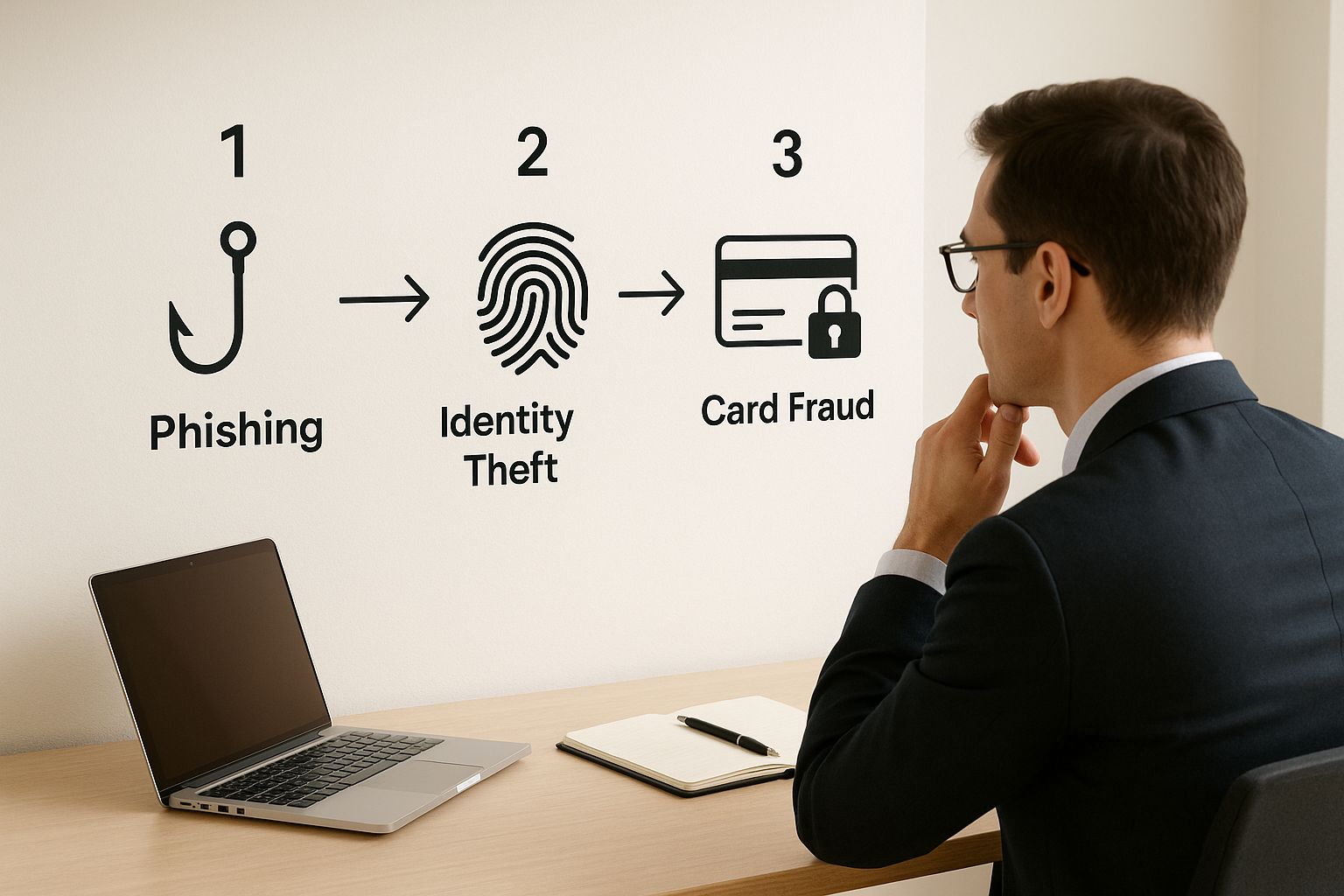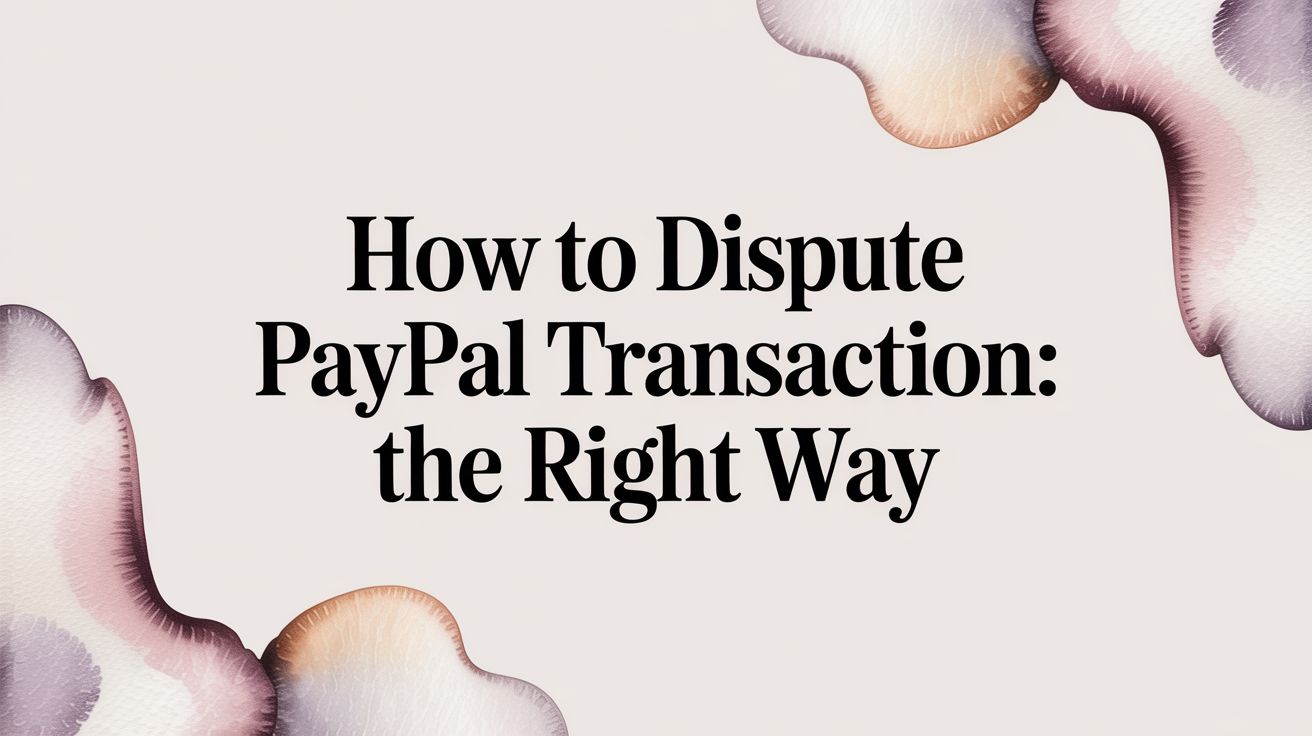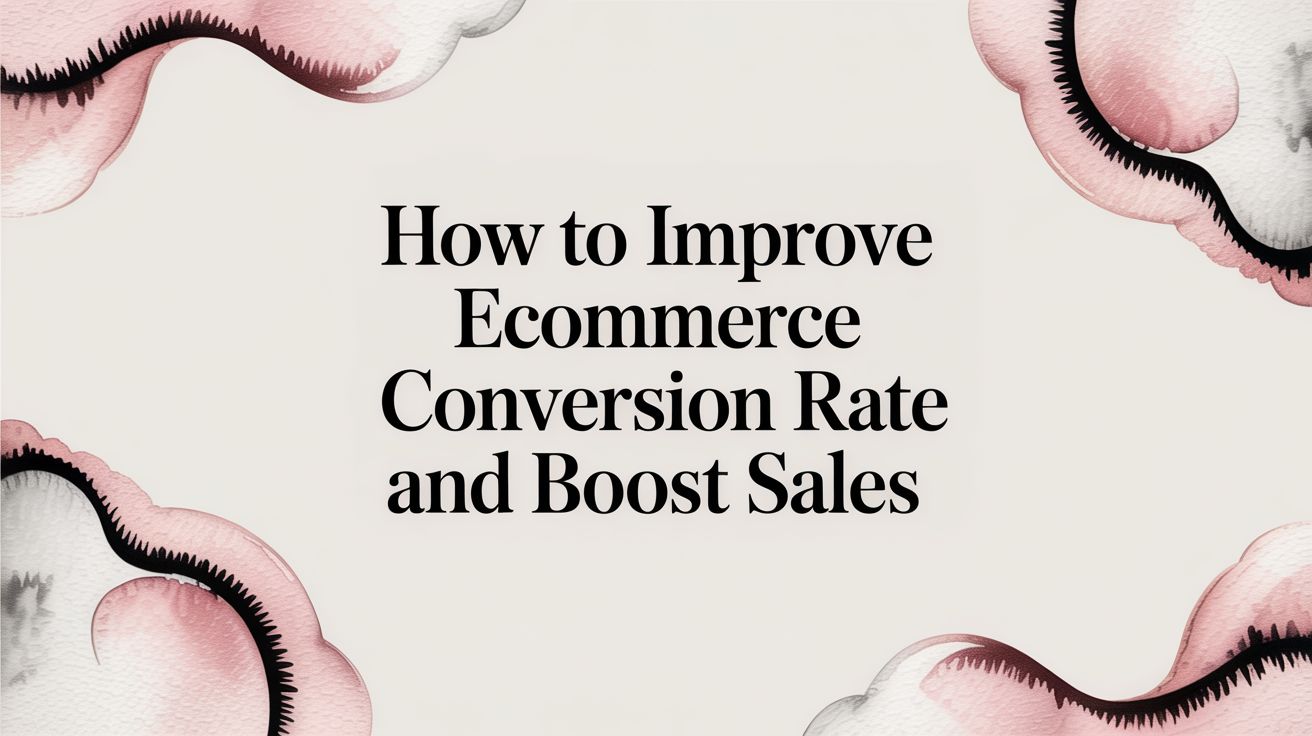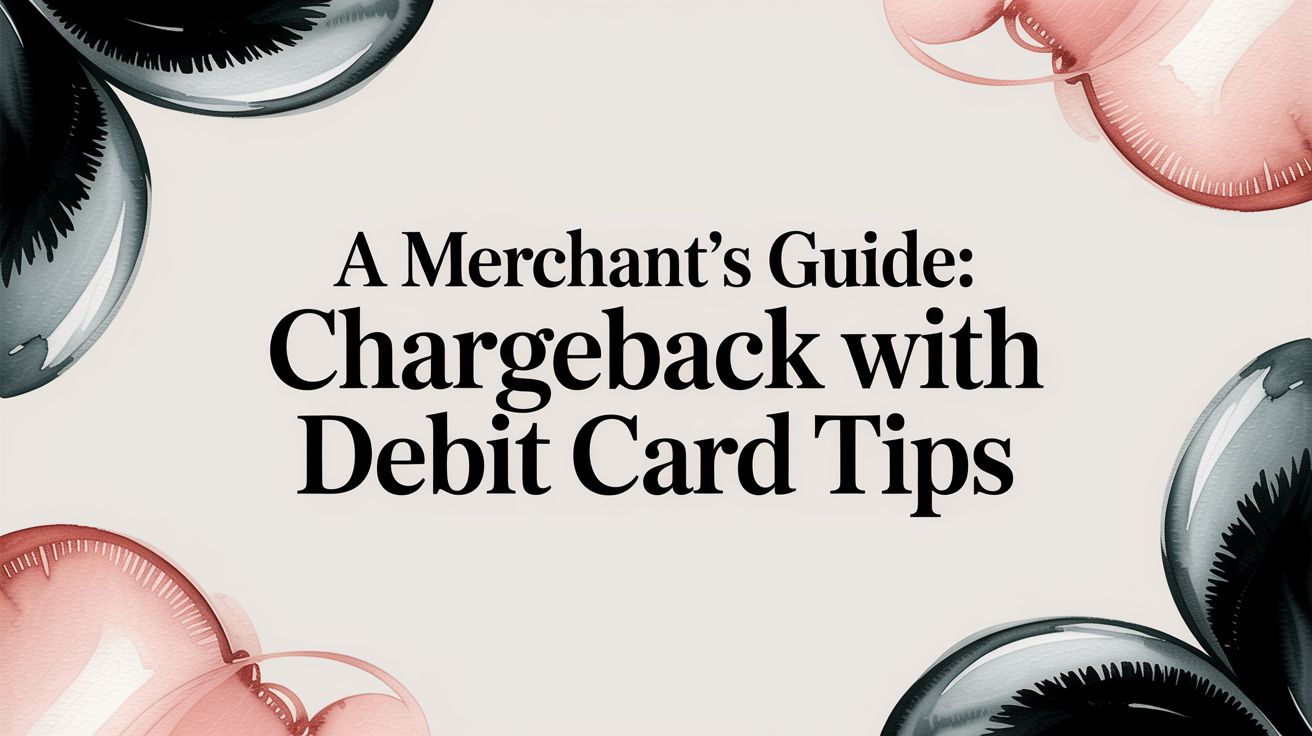
When you're running a business, the terms "fraud" and "dispute" probably sound like two flavors of the same expensive headache. But here’s the thing: they are fundamentally different problems, and knowing how to tell them apart is your first line of defense.
The key difference boils down to one word: intent. A dispute is usually a customer service issue where someone is unhappy or confused. Fraud, on the other hand, is a deliberate act of deception designed to steal from you. Getting this right from the start is crucial for protecting both your revenue and your customer relationships.
Decoding Fraud and Disputes in Your Business
Let's use a simple restaurant analogy. A customer who sends their steak back because it's overcooked has a dispute. They’re not happy with what they received, and there’s a problem you can solve. Now, imagine someone who eats a three-course meal and then sprints out the door without paying. That’s fraud. One is a service mishap; the other is straight-up theft.
The same logic applies to e-commerce. A dispute happens when a package shows up late or the item is a different color than the customer expected. They are genuinely dissatisfied. Fraud is when a criminal uses a stolen credit card to buy something, knowing full well they have no right to the funds.
The core principle is simple: a dispute is a problem that can often be solved with good communication, while fraud is a crime that must be stopped. Recognizing which one you're facing determines your entire response strategy.
The Role of Intent
Intent is the bright, clear line separating these two issues. A customer filing a dispute genuinely believes they are in the right, even if they're mistaken. Maybe they forgot about a recurring subscription fee or don't recognize your business name on their bank statement. Their goal isn't to rip you off; it's to fix what they see as an error.
A fraudster has no such honest intentions. From the very beginning, their goal is to get goods or services without paying for them. They rely on deception, stolen information, or manipulative tactics to make it happen. You can’t resolve this with a friendly email or a replacement product, because there was never a legitimate customer to begin with.
Treating a confused customer like a criminal is a surefire way to lose them forever. On the flip side, treating a fraudster like a valued client just opens you up to more attacks. For a deeper dive into this topic, you can explore more about how to handle different types of disputes and chargebacks in our detailed guide.
Fraud vs Dispute at a Glance
To make this crystal clear, it helps to see how these two scenarios stack up side-by-side. The warning signs, motivations, and your ideal responses are worlds apart.
This table breaks down the essential differences at a glance:
By quickly identifying whether you're dealing with a legitimate customer issue or a malicious attack, you can take the right actions every time to protect your business.
How the Chargeback Process Actually Works
The chargeback process often feels like a mysterious, winding path where merchants have little control. But once you understand the map, you can navigate it with confidence. Think of it as a formal, regulated conversation between banks, with you and your customer sitting at opposite ends of the table.
It all kicks off when a cardholder calls their bank—known as the issuing bank—to contest a charge. That one phone call sets off a chain reaction, a multi-stage process that can drag on for weeks or even months. Almost immediately, the disputed funds are pulled from your account.
This infographic breaks down the common types of fraud that often trigger these disputes, such as phishing, identity theft, and good old-fashioned card theft.

Getting a handle on these threats is your first line of defense. Each one requires a different strategy and a different set of evidence to successfully fight back against a chargeback.
The Key Players and First Steps
Four main parties are involved in every chargeback tango: the customer, the merchant (that’s you), the customer's bank (issuing bank), and your bank (acquiring bank). When the customer initiates the dispute, their bank files the chargeback and gives them a provisional credit.
At the same time, those funds are yanked from your merchant account. And to add insult to injury, you get slapped with a non-refundable chargeback fee, which can be anywhere from $20 to $100. Just like that, you're out the sale, the product, and you've paid a penalty for the trouble. Now, the clock is ticking for you to prove the transaction was legitimate.
This is where the pressure really starts. The card network, like Visa or Mastercard, assigns a specific reason code to the chargeback, which is their shorthand for telling you why the customer is disputing the charge.
The Representment Stage: Your Chance to Fight Back
This is where you get to tell your side of the story. Representment is the official term for challenging the chargeback by sending compelling evidence to your acquiring bank. It's your one shot to prove the transaction was valid and that you held up your end of the bargain.
Your evidence package has to be laser-focused on the reason code. For instance:
- Item Not Received: If the customer claims they never got the product, you need to hit back with shipping confirmations, tracking numbers, and definitive proof of delivery.
- Not as Described: For this one, you’ll need to submit product descriptions, photos from your website, and any emails with the customer where you tried to sort things out.
- Fraudulent Transaction: To fight a fraud claim, your best weapons are things like AVS (Address Verification Service) matches, CVV confirmations, and IP address logs from the time of purchase.
Once you’ve gathered your evidence, you submit it to your acquiring bank. They review it and pass it along to the issuing bank, who ultimately makes the call. For a deep dive into the specific timelines and rules, our guide on the Visa chargeback process is a fantastic resource.
Remember, the burden of proof is entirely on you, the merchant. A disorganized or incomplete evidence submission is almost a guaranteed loss, making this stage the most critical moment in the entire process.
Arbitration: The Final Showdown
So what happens if the issuing bank still sides with their customer, even after you’ve presented solid evidence? In some situations, you can take the fight to arbitration. This is the last resort, where the card network itself steps in to act as the final judge.
Be warned: arbitration is an expensive, time-consuming affair. It comes with even more fees that can hit $500 or more, and there's no guarantee you'll win. Because of this, most merchants only go down this road for very high-value transactions where the potential payoff justifies the risk and cost.
This is why the real battle is won or lost during representment. Building a rock-solid case with clear, undeniable evidence isn’t just your best strategy—it’s your only one for recovering revenue and defending your business.
Common Types of Transaction Fraud to Watch For

If you want to get a handle on fraud and disputes, you first need to know your enemy. Fraud isn't just one big, scary monster; it's a collection of different tactics, each with its own signature moves and warning signs. Knowing what you're up against is the first step toward building a solid defense for your business.
Think of it like setting up a home security system. You wouldn't use the same defense for a burglar picking a lock as you would for a scammer trying to trick you into giving up your alarm code. When you can recognize the specific threat, you can use the right tools and strategies to stop it cold.
Classic Credit Card Fraud
This is the one that probably pops into your head when you hear the word "fraud." It's a straightforward smash-and-grab where a criminal uses stolen credit card information—the card number, expiration date, and CVV—to make unauthorized purchases from your store.
That information can get stolen in a million ways, from physical card skimmers at gas pumps to massive data breaches at huge corporations. For you, the merchant, the red flags are often subtle but very telling.
Keep an eye out for these warning signs:
- Mismatched Addresses: The billing address is in one state or country, but the shipping address is somewhere completely different.
- Rapid-Fire Orders: A brand-new customer places several orders in a very short amount of time, often for your most expensive items.
- Gibberish Email Addresses: The email used for the order is a jumble of random letters and numbers, like
asdfg876h@email.com.
These signs don't always point to fraud, but they're strong signals to hit the pause button and take a closer look before you ship anything out the door.
Deceptive Friendly Fraud
This is easily one of the most frustrating types of fraud and dispute situations you'll ever face. Friendly fraud is when a real customer makes a purchase but then disputes the charge with their bank. They might claim it was unauthorized or that the product never arrived—even when you know it did.
Unlike traditional fraud, the card isn't stolen. The person making the claim is the actual cardholder. Sometimes it’s an honest mistake; they might have forgotten about the purchase or don't recognize your business name on their bank statement. Other times, it's a deliberate attempt to get something for free, often called "chargeback abuse." You can dive deeper into e-commerce chargeback fraud in our dedicated article to learn more.
Friendly fraud is so tricky because you're dealing with a real customer, not a faceless thief. Proving they received and are using the product is your only real defense, which makes detailed delivery confirmations and customer communication records absolutely critical.
Sophisticated Account Takeover Fraud
Account takeover (ATO) is a much more advanced scheme where a fraudster gets into a legitimate customer's account on your site. They usually get the login details from phishing scams or buy them on the dark web after another website suffers a data breach.
Once they're in, the fraudster changes the shipping address, places orders with the saved credit card, and might even burn through the customer's loyalty points. Your real customer is left with a bunch of charges they didn't make, and you're left with the chargeback.
Look for these ATO red flags:
- Sudden Account Changes: A customer who hasn't ordered in months suddenly logs in, changes their shipping address, and places a huge order for a pricey item.
- Multiple Login Failures: You see a string of failed login attempts followed by a successful one from a completely new device or location. This can signal a brute-force attack.
- A Spike in Password Resets: A sudden jump in password reset requests, especially if they're coming from unusual IP addresses, is a massive warning sign.
By spotting these patterns, you can get ahead of the problem, protect your customers' accounts, and stop fraudulent transactions before they turn into costly chargebacks.
Building Your Fraud and Dispute Prevention Plan

The single best way to win a chargeback fight is to make sure it never happens in the first place. A proactive prevention plan is your greatest weapon in the ongoing battle against both fraud and disputes. It’s all about building a fortress around your transactions—one with layers of security that stop bad actors cold, without getting in the way of your real customers.
Think of it like securing your home. You don’t just lock the front door; you shut the windows, maybe set an alarm, and leave the porch light on. Every layer adds more protection. For an e-commerce store, this means mixing powerful tech tools with smart, clear-cut customer service to cover all your bases.
Your Technical First Line of Defense
The first layer of defense is all about the automated tools working behind the scenes to check transactions the moment they’re made. These systems are your digital bouncers, checking the ID of every purchase before it gets the green light. They’re absolutely essential for catching the most obvious signs of fraud before a single product leaves your warehouse.
Some of the most effective tools out there include:
- Address Verification Service (AVS): This is a fundamental check. It simply compares the billing address the customer typed in with the one their bank has on file. A mismatch is a classic red flag for a stolen card.
- Card Verification Value (CVV): That little three or four-digit code on the back of a credit card is powerful. It’s a solid piece of proof that the person making the purchase actually has the physical card.
- 3D Secure (e.g., Verified by Visa, Mastercard SecureCode): This adds one more step to the checkout process, often asking the customer for a password or a one-time code sent to their phone to prove it’s really them.
Putting these tools in place creates some serious hurdles for fraudsters, making your store a much less appealing target. For a deeper dive, our complete guide is packed with more info on chargeback prevention techniques.
A layered security approach doesn’t just stop one type of fraud; it creates a web of verification that makes nearly all fraudulent activity harder to execute. Each check is another hurdle a criminal must overcome.
The Power of Smart Transaction Rules
Beyond these standard checks, you can get more specific by setting up smart rules to automatically flag or even block orders that look suspicious. These rules work like a seasoned store manager who can spot a sketchy situation from a mile away. The best part is you can tailor them to what’s normal for your business.
Consider setting up rules that trigger a manual review for things like:
- High-Value Orders: Any order that’s way bigger than your average sale should get a second look. This gives you a chance to confirm it's legitimate before shipping out a high-ticket item.
- Velocity Checks: This lets you limit how many times a single customer or IP address can try to make a purchase in a short window. It’s a great way to shut down those rapid-fire fraud attempts.
- IP Geolocation Mismatches: If an order is placed from an IP address in one country, but the billing and shipping addresses are in a totally different one, it’s definitely worth investigating.
Preventing Disputes with Great Service
Technical tools are fantastic for catching crooks, but they do almost nothing to stop disputes from honest customers. That’s where the human element comes in. The truth is, many disputes are born from simple misunderstandings, confusion, or just plain bad communication.
Start by making your customer service team incredibly easy to find. If a customer has a problem and can’t get in touch with you quickly, their next call is going to be to their bank. It’s also critical to make sure your billing descriptors—the name that shows up on their bank statement—are crystal clear. If they see "XYZ Corp" instead of "Molly's Flower Shop," they might not recognize the charge and immediately assume it’s fraud.
In the same vein, protecting your brand with Amazon Brand Registry can stop counterfeit products from souring the customer experience and leading to disputes. Things like transparent return policies, proactive shipping updates, and friendly support can solve countless problems before they ever get close to becoming a chargeback.
How AI Automation Simplifies Fraud and Dispute Cases
Trying to manage every fraud alert and customer dispute by hand is like trying to catch rain in a bucket during a hurricane. It’s an overwhelming, exhausting process that almost guarantees you’ll miss something critical. This manual approach isn't just slow; it's wide open to costly human errors that can eat into your revenue.
This is where technology, specifically Artificial Intelligence (AI), completely changes the game for merchants. AI isn’t just about speeding things up—it's about getting smarter. Modern AI tools can analyze thousands of transaction data points in a split second, spotting complex patterns a human could never hope to catch on their own.
Beyond Human Capabilities
Think about it this way: an AI system can instantly cross-reference a customer's purchase history, IP address, device fingerprint, and hundreds of other variables to calculate a real-time risk score. It can identify the faint, subtle links between what look like unrelated orders, signaling a coordinated fraud attack.
While your team is busy digging into one suspicious order, an AI has already analyzed ten thousand more.
This means AI acts as a super-powered fraud expert that works for your store 24/7. It flags high-risk transactions with incredible accuracy, giving you the power to stop fraudulent orders before they’re even processed. This proactive defense is your best bet for minimizing losses from the very start.
The real power of AI is its ability to learn and adapt. Every transaction, every dispute, and every outcome teaches the system to get better, making your fraud detection smarter and more precise over time.
Automating the Entire Dispute Process
Catching fraud is only half the battle. When a dispute turns into a chargeback, the manual work of fighting it is a massive time sink. You have to hunt down order histories, track down shipping confirmations, and piece together a compelling case for the bank—all while a strict deadline is ticking down.
AI automation takes this entire burden right off your shoulders. Instead of you manually gathering all the evidence, an AI-powered system does it for you automatically.
It instantly pulls together all the necessary documents for representment:
- Order Details: The exact items purchased, plus timestamps and customer info.
- Proof of Delivery: Tracking numbers and delivery confirmations straight from the shipping carriers.
- Customer Communications: Any relevant emails or chat logs that back up your case.
- Fraud Prevention Data: AVS and CVV match results that help prove the transaction was legitimate.
Once the evidence is collected, the system can even generate a professional, well-structured response and submit it directly to the bank on your behalf. This doesn't just save you countless hours; it significantly boosts your chances of winning. Businesses using this approach often see their win rates climb because the evidence is always complete, accurate, and submitted on time.
This hands-free approach allows you to recover more revenue without lifting a finger. If you want to see exactly how this works from start to finish, check out our complete guide to automated chargeback and dispute management using AI. The benefits are clear: better efficiency, greater accuracy, and more money back in your bank account.
Frequently Asked Questions About Fraud and Disputes
As you get deeper into the world of e-commerce, you start running into the same questions about payments, fraud, and customer issues. Let's tackle some of the most common things merchants ask when they're trying to protect their business.
What Is the Difference Between a Chargeback and a Refund
Think of a refund as a friendly, two-way conversation. You and the customer agree that a purchase didn't work out, and you voluntarily return their money. It's a direct agreement, keeping things simple and keeping the banks out of it.
A chargeback, on the other hand, is when the customer goes straight to their bank to force the money back. They bypass you entirely, and the bank yanks the funds from your account while they launch an investigation. This process involves the entire card network, comes with hefty fees, and can damage your reputation with payment processors.
Is It Possible to Prevent All Chargebacks
Honestly, preventing 100% of chargebacks is just not realistic, especially with "friendly fraud" on the rise. The real goal isn't total elimination—it's aggressive reduction. You can get pretty darn close by combining smart fraud detection tools (like AVS and CVV checks) with top-notch customer service.
The goal isn't total elimination but significant minimization. By making it easy for customers to contact you and having a fair return policy, you can resolve countless issues before they ever escalate into a formal dispute.
Proactive problem-solving is always your best defense. Beyond transaction-level issues, merchants often face platform-specific challenges; for example, learning the Amazon account appeal process can help resolve conflicts that threaten your entire storefront.
How Long Do I Have to Respond to a Chargeback
Once a chargeback is filed, the clock starts ticking. You typically have a window of 20 to 45 days to respond with your evidence—a process known as representment. This timeframe isn't set in stone; it varies depending on the card network, like Visa or Mastercard.
It is absolutely critical to act fast. This is your one and only shot to submit compelling proof that the transaction was legitimate. We're talking order confirmations, shipping receipts, tracking numbers, and any emails you exchanged with the customer. If you miss that deadline, you automatically lose the dispute, the revenue, and the product.
What Is a Chargeback Ratio and Why Does It Matter
Your chargeback ratio is a simple but vital health metric for your business. To find it, you just divide the number of chargebacks you received in a given month by your total number of transactions. For instance, if you had 10 chargebacks and 1,000 transactions, your ratio is 1%.
So why does this little number matter so much? Because the card networks and payment processors are watching it like a hawk. If your ratio creeps above their threshold—usually around 0.9%—they'll flag you as a "high-risk" merchant. This can trigger a cascade of problems, from higher processing fees and frozen funds to losing your merchant account entirely. It's a metric you can't afford to ignore.
Stop letting manual dispute management drain your time and revenue. ChargePay uses AI to automatically fight and win chargebacks for you, recovering up to 80% of your lost funds without you lifting a finger. Reclaim your revenue today.







.svg)







.svg)
.svg)
.svg)